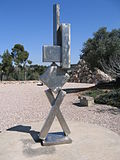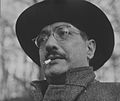 "Greenwich Village" by Felix Stahlberg, 2017. | |
 | |
| Date | Monday, May 21, 1951 to Sunday, June 10, 1951 |
|---|---|
| Duration | 20 days |
| Venue | 60 East 9th Street, New York, New York 10003 |
| Location | Greenwich Village, Manhattan, New York City, United States |
| Also known as | "Ninth Street Show" and "9th Street Show" |
| Type | Abstract Expressionism |
| Theme | Group Show |
| Organized by | Leo Castelli, curator and financial backer. Franz Kline, promotional designer. Aaron Siskind, event photographer. |
| Participants | Key figures in abstract expressionism, America's first internationally influential art movement. |
The 9th Street Art Exhibition of Paintings and Sculpture is the official title artist Franz Kline hand-lettered onto the poster he designed for the Ninth Street Show (May 21-June 10, 1951). [1] [2] Now considered historic, the artist-led exhibition marked the formal debut of Abstract Expressionism, and the first American art movement with international influence. The School of Paris, long the headquarters of the global art market, typically launched new movements, so there was both financial and cultural fall-out when all the excitement was suddenly emanating from New York. The postwar New York avant-garde, artists like Willem de Kooning and Jackson Pollock, would soon become "art stars," commanding large sums and international attention. [3] The Ninth Street Show marked their "stepping-out," and that of nearly 75 other artists, including Harry Jackson, Helen Frankenthaler, Michael Goldberg, Joan Mitchell, Grace Hartigan, Robert De Niro Sr., John Ferren, Philip Guston, Elaine de Kooning, Louis Schanker, Lee Krasner, Franz Kline, Ad Reinhardt, Ludwig Sander, David Smith, Milton Resnick, Joop Sanders, Robert Motherwell, Barnett Newman, and many others who were then mostly unknown to an art establishment that ignored experimental art without a ready market. [3]
Contents
- Organization
- The Club
- The Artists
- Exhibition funding and formal roles
- Legacy
- American art
- Women artists
- Related exhibitions
- External links
- Articles
- Posters
- Videos
- Notes and references
The artist-led show was intended to make names — and it did. [3] Word of the exhibition slipped out prior to the Monday night preview, but that only added to the interest. [3] Author Mary Gabriel writes, "Nothing sold, but no one cared. The exhibition had earned the artists attention on their own terms." [4] Their form of art — the New York School — was later called "the quintessential American and modern art movement." [5] At the time, however, "[i]t appeared as though a line had been crossed, a step into a larger art world whose future was bright with possibility." [6]















